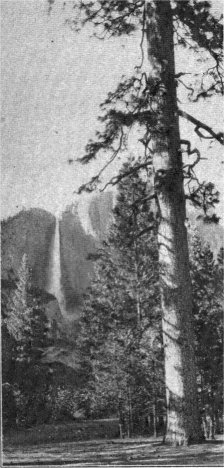
[click to enlarge]
| Online Library: | Title | Author | California | Geology | History | Indians | Muir | Mountaineering | Nature | Management |
Yosemite > Library > Cone-bearing Trees > Western Yellow Pine >
Next: Jeffrey Pine • Contents • Previous: Knobcone Pine
Pinus ponderosa Lawson.

[click to enlarge] |
Not only is this pine preeminent because of its wide distribution, large size, and wide environmental tolerance but among the Yosemite pines it has few rivals for beauty of symmetry and shapeliness. The narrow columnar crowns of young trees form perfect slender spires that shoot up to the skies on trim, straight trunks. Even in old age they retain this perfection of form to a remarkable degree although the crowns flatten with the development of large horizontal upper limbs. This slight loss of symmetry, however, is compensated for by the picturesque downward sweep of the main branches which always terminate in sharply ascending brush-like tufts of foliage.
The bright, yellow-green leaves are borne on the ends of naked branches and are densely clustered, forming handsome upright tufts consisting of long needles grouped in bundles of threes. The upturned ends of Western Yellow Pine branches and the long leaves are characteristic traits of this species greatly assisting in its identification from a distance. By far the most singular aspect, however, is the bark. The name Yellow Pine, although not specifically referring to the color of the bark, is certainly descriptive. No other conifer in Yosemite has a bark color that resembles the rich, light yellow of mature Western Yellow Pine. Thus, its identity is disclosed long before other tree characteristics can be examined. At closer hand, the bark is seen to be arranged into massive, flat plates measuring as much as three to four feet in length by one to two feet in width. This thick bark (three to four inches) consists of thin scales which, when peeled away, resemble the segments of jig-saw puzzles.
Although these characters are distinctive of mature trees, the color of the bark of younger Western Yellow Pines is black or brownish with lighter yellow and orange shades in the young trees is very rough with narrow ridged plates. The scales are so compact that they cannot be easily divided into individual flakes. These differences between the older and younger bark tend to confuse many park visitors who immediately recognize the mature “yellow” forms, but do not realize that the smaller, darker barked trees around their camps are of the same species.
There is a unique even-aged stand of pines in Yosemite Valley. In searching for a reason, one finds it disclosed in early photographs, in statements in the literature, and in information supplied by old Indians. It appears that a smart sort of agriculture was practiced by these dwellers in Ah-wah-nee. Acorns of the Black Oak furnished certainly eighty per cent of the Indian’s annual food supply. They knew that their “orchards” of oaks could not compete with the fast growing pines. Consequently, each spring as the snow retreated, controlled ground fires were started in the grass along the edges of the encroaching pine thickets in order to kill the pine seedlings. The Indians are gone now, burnings are stopped, a valley once three-fourths open land has been encroached upon by a vigorous pine growth until it is now nearly three-fourths forested. Park visitors have benefited by this change. They pitch their tents under Yellow Pines and enjoy the shade and inspiration that comes from camping beneath and amongst them.
Next: Jeffrey Pine • Contents • Previous: Knobcone Pine
| Online Library: | Title | Author | California | Geology | History | Indians | Muir | Mountaineering | Nature | Management |
http://www.yosemite.ca.us/library/cone-bearing_trees/western_yellow_pine.html